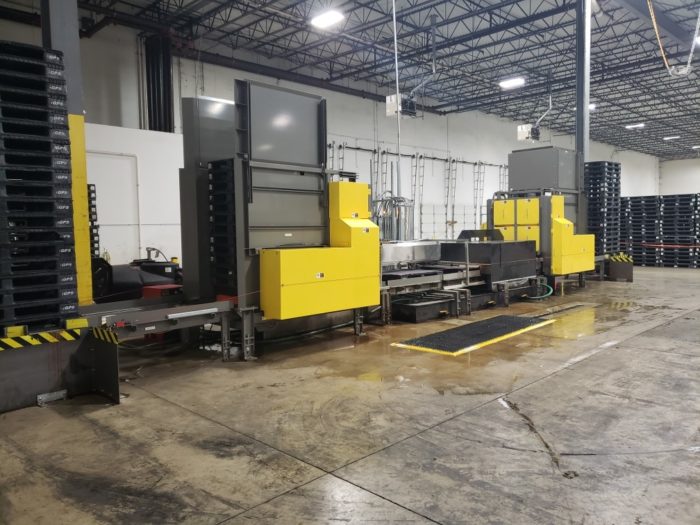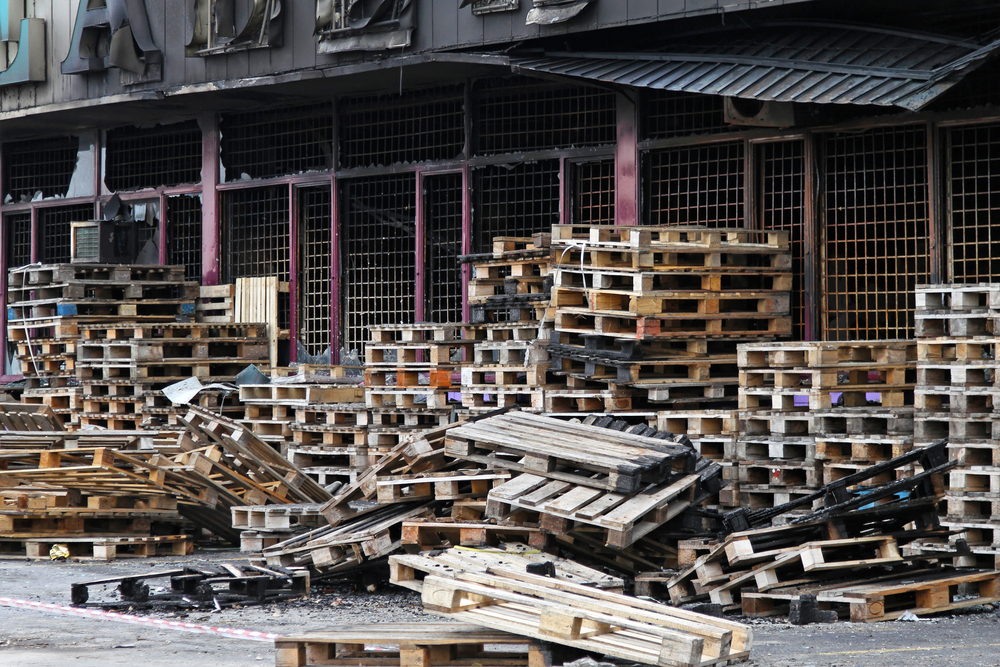The modern supply chain is built upon the use of pallets. They provide a platform that allows consumer goods to be easily moved by heavy equipment, and without them it would be impossible to transport raw materials, food, and consumer goods with the speed and in the amounts needed to make modern society possible. It may come as a surprise to some, then, that disposing of used pallets is an ongoing problem. However, if you’re a retail manager, a factory operations manager, an equipment installer, a construction site supervisor, or a warehouse manager, you’ve probably had to deal with unclaimed pallets at least once–and most likely many times.
The problem of how to get rid of pallets is a common one because while even used pallets do have intrinsic value, it often isn’t enough to justify the hassle of reclaiming the pallets or the fuel costs of transporting empty pallets. Stringer pallets have a very short lifespan of just a couple of trips through the supply chain and it’s often cheaper to buy new pallets than it is to find a destination for used ones. As a result, those at the end of the supply chain often end up paying to have pallets trucked away, paying fines for improperly disposing of pallets, or being fined for failing to dispose of them. This is a widespread problem, and even companies that specialize in disposing of pallets may struggle to keep up.
How Pallets Get Abandoned
 Although it should be common knowledge, a surprising number of managers and others in retail don’t know that complexes like malls, strip malls, business parks, and industrial parks contract out their daily and weekly property upkeep to facilities maintenance companies that maintain vacant spaces, patch small holes in asphalt, remove trash from parking lots, and ensure trash is properly disposed of in the rear areas of the complexes. Much of what they deal with is used pallets.
Although it should be common knowledge, a surprising number of managers and others in retail don’t know that complexes like malls, strip malls, business parks, and industrial parks contract out their daily and weekly property upkeep to facilities maintenance companies that maintain vacant spaces, patch small holes in asphalt, remove trash from parking lots, and ensure trash is properly disposed of in the rear areas of the complexes. Much of what they deal with is used pallets.
Location managers in a diverse number of fields have found their budgets impacted by not knowing how to get rid of pallets in an appropriate manner.
While grocery and convenience stores receive orders routinely, stores that sell more durable products require smaller, more irregular deliveries. This means that generally only a few pallets need to be delivered at a time, and, as a result, pallet resale and refurbishment companies have little incentive to pick them up. This leads to pallets left behind tenant spaces, where one of three things will usually happen:
- Improper Disposal: The tenant will place the pallets in a dumpster and be fined by the waste management company. Tenants sometimes dump their pallets into another tenant’s dumpster to avoid disposal fees or fines.
- Fire Code Violations: Improperly stored pallets are against the fire code in many areas. If the local inspection authority notices improperly stored pallets behind a retail space, they will either issue a warning or a fine. This is uncommon since inspectors often have busy schedules inspecting new construction, but it does happen–especially if pallets have been allowed to pile up over time.
- Disposal Fees: Most commonly, the contracted facilities maintenance company will notice abandoned pallets, dispose of them, and then charge the complex management company a large fee for bulk rate disposal. The management will then charge this fee to the tenant responsible for the pallets.
The costs assessed in these situations can be substantial and usually an unpleasant surprise to the affected tenant. As a result, location managers in a diverse number of fields have found their budgets impacted by not knowing how to get rid of pallets in an appropriate manner.
How to Get Rid of Pallets Properly and Safely
 Perhaps the best way to get rid of pallets is simply to reuse them. Direct reuse of pallets is the most economical use of the materials. The second best way is to recycle them. This can be accomplished by refurbishing used wood pallets and mulching them at the end of their lifespan. However, where recycling and refurbishing wood stringer pallets is economically viable, it is already widely practiced. Stores and warehouses that routinely receive large batches of stringer pallets already sell them to their local pallet resellers. The difficulty of how to get rid of pallets applies mainly to the semi-regular deliveries that arrive at many retail stores. The solution may be to copy the model typically used by grocery stores.
Perhaps the best way to get rid of pallets is simply to reuse them. Direct reuse of pallets is the most economical use of the materials. The second best way is to recycle them. This can be accomplished by refurbishing used wood pallets and mulching them at the end of their lifespan. However, where recycling and refurbishing wood stringer pallets is economically viable, it is already widely practiced. Stores and warehouses that routinely receive large batches of stringer pallets already sell them to their local pallet resellers. The difficulty of how to get rid of pallets applies mainly to the semi-regular deliveries that arrive at many retail stores. The solution may be to copy the model typically used by grocery stores.
When a pallet reaches the end of the supply chain, the pooling company picks up the pallet, sorts and inspects it, and directs it to the next client
Grocery stores and other retailers with a high product throughput use a pallet pooling system. Instead of purchasing pallets for use and developing storage facilities and reverse logistic routes for those pallets, they turn to a more cost-effective pallet management strategy: renting pallets from a pooling provider. When a pallet reaches the end of the supply chain, the pooling company picks up the pallet, sorts and inspects it, and directs it to the next client. This reduces the amount of travel needed between different locations in order to reuse the pallet and makes pallet reuse more economical and efficient.
When the pallets rented through a pooling system are plastic pallets rather than traditional wood pallets, they can be reused many more times and recycled at the end of their lifespan instead of ending up in a landfill. High-quality plastic pallets can be picked up, washed, and shipped out again as many as 100 times before being remolded into “new” plastic pallets, giving them true cradle-to-cradle recyclability. Plastic pallets are a truly sustainable way to transport products, and plastic pallet pooling is an elegant solution to the problem of how to get rid of pallets.
The iGPS plastic pallet is a rental shipping platform available nationwide through iGPS’ pallet pooling service. To make the switch, give our team a call at 1-800-884-0225, email a specialist at switch@igps.net, or visit our contact page.



